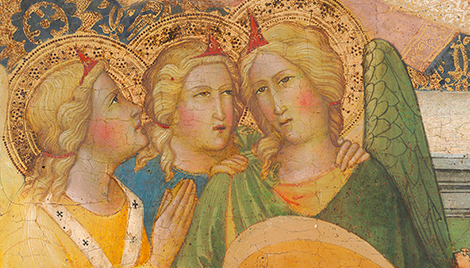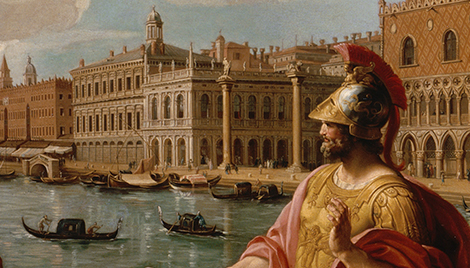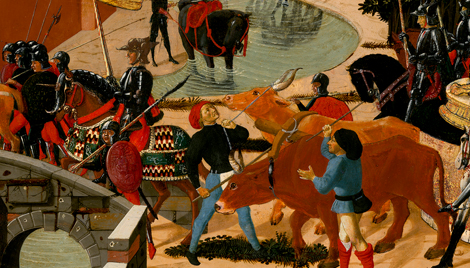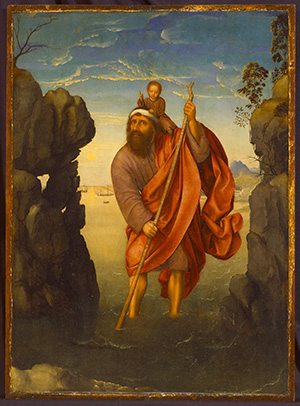Saint Christopher
Saint Christopher
- Artist
- Workshop of Quentin Massys
- Artist Dates
- 1466-1530
- Artist Nationality
- Dutch; Netherlandish
- Title
- Saint Christopher
- Date
- c. 1490
- Medium
- oil on oak panel
- Dimensions
- 66.6 x 48.3 cm (26-1/4 x 19 in)
- K Number
- K1903
- Repository
- Allentown Art Museum
- Accession Number
- 1961.047.000
- Notes
Provenance
Dr. von Cranach, Wartburg, Thuringen, Germany. [1] (M. Knoedler and Co., New York); sold 6 February 1952 to the Samuel H. Kress Foundation, New York; [2] gift to the Allentown Art Museum in 1961, no. 1961.47. [1] According to information provided by Knoedler. [2] M. Knoedler and Co. Records,Getty Research Institute. Series II, Box 76 (Sales Book No. 16, Paintings, 1945-1953), Series IV, Box 128; Series I Box 9. Knoedler Number A4468.
Catalogue Entry
Workshop of Quentin Massys
Saint Christopher
K1903
Allentown, Pennsylvania, Allentown Art Museum (61.47.G) since 1960. Oil on oak. 26 1/4 x 19 in. (66.6 x 48.3 cm.). Cleaned, cradled, and restored by Modestini in 1952/53. Split down center of panel; well preserved. Allentown, 1960, p. 88. Reproduced in color in Seymour, p. 77, fig. 69. St. Christopher, in a purple tunic and flowing red mantle and a white head-band, grasping a staff, is seen almost frontally. The Infant, in a purple robe, is perched on Christopher's shoulder. His right hand raised in benediction, Christ grasps Christopher's head-band with the other. The giant saint stands in the harbor water, cliffs to the left and right, ships and mountains in the distance. The setting sun gives a yellow tinge to clouds in the blue sky. Christopher (the Greek word for Christ-bearer) was a human ferry who bore people across a river. The Christ Child grew, as the ferryman carried him, increasingly heavy: an allegory of Christ bearing the sins of the world.(1) The composition of K1903 is based upon a lost Eyckian work known from a silverpoint drawing in the Louvre (Cabinet des Dessins) and a panel painting sometimes attributed to Dieric Bouts (John G. Johnson Collection, Philadelphia Art Museum). Many Netherlandish painters in the mid-and late fifteenth century continued utilizing the composition, most notably Bouts and Memling.(2) The Kress panel is extremely close to an early depiction of the same subject by Quinten Massys (Antwerp, Musee Royal des Beaux-Arts) and to a painting attributed to Albert Bouts, probably dating c. 1490 (Modena, Galleria Estense).(3) Christopher's pose is reversed in the Antwerp painting. While shown parallel with the cliffs in the Kress panel, the saint is placed before the cliffs, nearer the picture plane, in the Antwerp work. Christopher's drapery, the Infant, and the landscape of K1903 are closer to the Modena panel than to the Antwerp example. The Kress panel omits the hermit with lantern seen on the left in the Antwerp painting. Friedlander gave K1903 to Quinten Massys.(4) Payne stressed the correspondence of K1903 to the Modena panel and found the attribution of the Kress example to Massys himself dubious.(5) Shapley (Allentown, p. 88) dated K1903 c. 1490, approximately contemporary with the Antwerp painting by Massys, and accepted his authorship for the Kress panel. The high finish and almost microscopically rendered detail of the Kress panel suggest its execution by a master who was close to Jan Gossart's aesthetic and active in Massys' circle. Such an artist executed panels now in Portugal in the style of K1903.(6) Provenance: Dr. von Cranach, Wartburg, Thüringen, Germany, according to Knoedler. New York, M. Knoedler and Co. Kress acquisition 1952, exhibited –Art Treasures for America, Washington, D.C., National Gallery of Art, 10 Dec. 1961-4 Feb. 1962, Cat. No. 61.
References
(1) For the iconography of St. Christopher, see Réau, III, I, pp. 304-13. (2) For depictions of Christopher by Bouts and his circle, see Wolfgang Schone, Dieric Bouts und seine Schule, Berlin-Leipzig, 1938, pp. 143 ff. (3) For the Antwerp painting, see Max J. Friedlander, Die altniederländische Malerei, VII, Leyden, 1934, pp. 33, 119, Cat. No. 32, pl. 31. See also Friedlander, 'Quentin Massys: Reflexions on his Development', Burlington Magazine, LXXII, 1938, pp. 53-4. For the Modena painting see Friedlander (Die altniederländische Malerei, III, Berlin, 1925, p. 121, Cat. No. 71, pl. LXIII) and Schone (op. cit., Cat. No. 125, p. 144), who believed it to be copied after a lost Dieric Bouts of c. 1470. The Kress panel may be more directly based upon a lost Dieric Bouts than upon either the Antwerp or Modena paintings. (4) Certificate in Kress Archive, 1950. (5) Jensene Godwin Payne, 'The iconography of St. Christopher in Fifteenth Century Netherlandish Painting', M.A. thesis, New York University, 1964, p. 61. (6) See Luis Reis-Santos, 'Edouard Portugalois, disciple et collaborateur de Quentin Massys', Pantheon, XXVI, 1968, pp. 185-96, pls. 12a, 12b, two wings in Lisbon, Museu Nacional de Arte Antiga.






